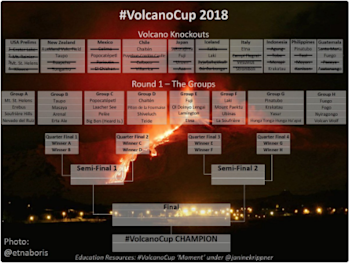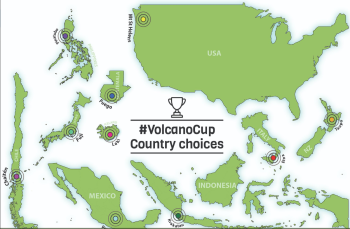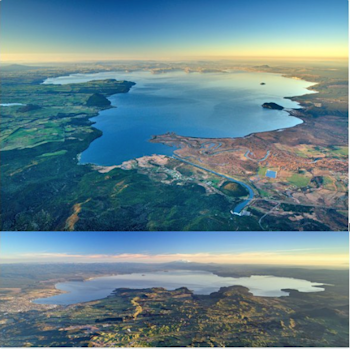
Taupo Volcano gets to represent New Zealand in Volcano Cup 2018
Taupo was voted in to represent New Zealand in the preliminary VolcanoCup round and is today facing the world in ‘Round 1’ of the group eliminations.
If you have been following the volcanogeekery on Twitter this last two weeks, you’ll know that Taupo volcano (a caldera) was voted in to represent New Zealand in the #VolcanoCup! While Taupo volcano is certainly more than capable of footing it on the world stage - the producer of some of the largest eruptions on Earth - she needs your help today to get through to the next round as she is up against some foreign volcanic heavyweights.
To vote, find @janinekrippner, a Kiwi volcanologist in the States who is running the #VolcanoCup on Twitter, and there you will find a poll where you can cast your vote for Taupo. You can also follow the #VolcanoCup hashtag for nifty volcano facts and lots of international volcano nerdism and images.
Today is the second day of Round 1 of the Volcano Cup 2018 and Taupo Caldera is up against Masaya a caldera located in Masaya, Nicaragua, 20 km south of the capital Managua, Arenal in north-western Costa Rica and Erta Ale in the Afar Region of northeastern Ethiopia.
A bit about our VolcanoCup contestant, Taupo Volcano (Caldera)
While the other contenders to be New Zealand’s VolcanoCup representative – Ruapehu, Tongariro and the Auckland Volcanic Field – are more recently active, some would say more pretty, and have some interesting features like lahars and crater lakes, Taupo won out because she is big and bad.
You could be forgiven for thinking that Taupo is just a pretty lake to the north of some actual volcanoes, but don’t let appearances deceive. Taupo volcano started life around 200,000 years ago and has had two significant ‘caldera forming eruptions’, both holding their own in global volcanology.
The Oruanui eruption - which produced one of, if not the largest eruption in the world in the last 26,000 years – covered the central North Island in about 500-700 cubic kilometres of superhot gassy magma, laid down as an unwelded ignimbrite. The hole under the ground that was left after all this magma spewed out collapsed, forming a caldera, which got filled up with water – and the first Lake Taupo was formed.
The most recent eruption was the Taupo Pumice eruption about 1800 years ago, when about 45 cubic kilometres were deposited in the central North Island as valley fill ignimbrite and air fall pumice . Another caldera was formed and the modern Lake Taupo fills part of it. The effects of this eruption were recorded in China and Italy as unusual sunsets.
Although it hasn’t had a large eruption for 1800 years, we know that Taupo is still active because it shows signs of what we call ‘volcanic unrest’: small earthquakes, movement of the ground up and down, and changes in the geothermal fields in the area. There have been 17 episodes of volcanic unrest at Taupo in the last 140 years – you can learn more about them in GNS Science’s cool Taupo volcanic unrest video. Needless to say, GeoNet scientists monitor Taupo volcano very closely!
So, is Taupo a supervolcano? Using the term ‘supervolcano’ makes many volcanologists sad. It’s not a technical term that you learn at volcanology school, but was in fact invented by some people making a documentary about a potentially big, bad volcano somewhere. But now it gets used a lot, particularly in the media, to describe volcanoes that can produce really big eruptions that can cover hundreds of square kilometres in lava, ash and super-hot gas. So nah, it’s not a technical term, but yeah, in the way it gets used now you could call Taupo a supervolcano.
So it’s time to sharpen up your Twitter skills, find @janinekrippner and follow the hashtag #VolcanoCup and do New Zealand proud. In the elimination round #VolcanoCup was trending number 7 on Twitter. Let’s see if we can better that. Because the #VolcanoCup is run out of USA the voting is done in American Eastern Standard Time, so today’s round will run from 2 am Saturday 17 February to 2am Sunday 18 February.
If you’re interested in more about the completion…
Never heard of the volcanoes that Taupo is up against today? Masaya is a big volcano in Nicaragua which has had huge eruptions in the past and now spends its time constantly belching sulphur dioxide gas and occasionally exploding a big bits of rock into the air. Arenal is a beautiful cone volcano which was dormant for hundreds of years and covered in bush (hmmm, sounds a little like Taranaki), but then burst into life with a surprise violent eruption in 1968 that destroyed three nearby villages. And Erta Ale is Ethiopia’s most active volcano and has the world’s longest-lived lava lake – bubbling away for over 100 years and one of only six in the world. One of its craters is locally known as “the gateway to hell”.






